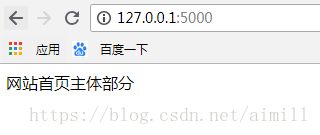目录
- include标签如何使用?
- include标签的使用
- 截图如下
- 总结
include标签如何使用?
include标签的使用
在讲python include标签使用之前,我们新建一个include_demo项目
截图如下

项目新建好了,再在templates文件下新建一个index.html文件,代码如下:
| <html lang="en"> | |
| <head> | |
| <meta charset="UTF-8"> | |
| <title>Title</title> | |
| <style> | |
| *{margin:0;padding:0;} | |
| ul{list-style: none;} | |
| a{text-decoration: none; | |
| color: #ffffff;} | |
| nav,footer,.main{width:1000px; height:40px; margin:0 auto;} | |
| ul{width: 1000px; height:40px; line-height: 40px; | |
| background-color:#000000;} | |
| li{width:120px; height:40px; line-height:40px; text-align: center; | |
| float:left;} | |
| .main{clear:both; line-height:40px; background-color:pink;} | |
| footer{height:40px; background-color: green;} | |
| </style> | |
| </head> | |
| <body> | |
| <nav> | |
| <ul> | |
| <li><a href="#" rel="external nofollow" rel="external nofollow" rel="external nofollow" rel="external nofollow" rel="external nofollow" rel="external nofollow" rel="external nofollow" rel="external nofollow" rel="external nofollow" rel="external nofollow" rel="external nofollow" rel="external nofollow" >首页</a></li> | |
| <li><a href="#" rel="external nofollow" rel="external nofollow" rel="external nofollow" rel="external nofollow" rel="external nofollow" rel="external nofollow" rel="external nofollow" rel="external nofollow" rel="external nofollow" rel="external nofollow" rel="external nofollow" rel="external nofollow" >关于我们</a></li> | |
| <li><a href="#" rel="external nofollow" rel="external nofollow" rel="external nofollow" rel="external nofollow" rel="external nofollow" rel="external nofollow" rel="external nofollow" rel="external nofollow" rel="external nofollow" rel="external nofollow" rel="external nofollow" rel="external nofollow" >产品中心</a></li> | |
| <li><a href="#" rel="external nofollow" rel="external nofollow" rel="external nofollow" rel="external nofollow" rel="external nofollow" rel="external nofollow" rel="external nofollow" rel="external nofollow" rel="external nofollow" rel="external nofollow" rel="external nofollow" rel="external nofollow" >新闻中心</a></li> | |
| <li><a href="#" rel="external nofollow" rel="external nofollow" rel="external nofollow" rel="external nofollow" rel="external nofollow" rel="external nofollow" rel="external nofollow" rel="external nofollow" rel="external nofollow" rel="external nofollow" rel="external nofollow" rel="external nofollow" >服务宗旨</a></li> | |
| <li><a href="#" rel="external nofollow" rel="external nofollow" rel="external nofollow" rel="external nofollow" rel="external nofollow" rel="external nofollow" rel="external nofollow" rel="external nofollow" rel="external nofollow" rel="external nofollow" rel="external nofollow" rel="external nofollow" >联系我们</a></li> | |
| </ul> | |
| </nav> | |
| <div class="main"> | |
| 网站首页主体部分 | |
| </div> | |
| <footer> | |
| 网站首页footer部分 | |
| </footer> | |
| </body> | |
| </html> |
然后在include_demo.py页面渲染一下index模板文件,代码如下:
| from flask import Flask,render_template | |
| app = Flask(__name__) | |
| def hello_world(): | |
| return render_template("index.html") | |
| if __name__ == '__main__': | |
| app.run(debug=True) |
运行include_demo.py文件,运行结果如下:

在这里主要是为了方便讲解include标签,所有没太注重前端页面部分。
通过上面index.html文件就能发现,我将公共和私有代码部分都在一块,假设网站有几十个页面,我将所有公共代码和私有代码
都放一块,如果有一天要修改某个公共代码块,哪就得修改几十个页面,那将是件非常麻烦的事。为了方便管理项目,我们将页面公共、私有代码部分抽取出来。
我们新建一个header.html文件,把css样式及nav标签内容复制到header.html页面中。
代码如下:
| <html lang="en"> | |
| <head> | |
| <meta charset="UTF-8"> | |
| <title>Title</title> | |
| <style> | |
| *{margin:0;padding:0;} | |
| ul{list-style: none;} | |
| a{text-decoration: none; | |
| color: #ffffff;} | |
| nav,footer,.main{width:1000px; height:40px; margin:0 auto;} | |
| ul{width: 1000px; height:40px; line-height: 40px; | |
| background-color:#000000;} | |
| li{width:120px; height:40px; line-height:40px; text-align: center; | |
| float:left;} | |
| .main{clear:both; line-height:40px; background-color:pink;} | |
| footer{height:40px; background-color: green;} | |
| </style> | |
| </head> | |
| <body> | |
| <nav> | |
| <ul> | |
| <li><a href="#" rel="external nofollow" rel="external nofollow" rel="external nofollow" rel="external nofollow" rel="external nofollow" rel="external nofollow" rel="external nofollow" rel="external nofollow" rel="external nofollow" rel="external nofollow" rel="external nofollow" rel="external nofollow" >首页</a></li> | |
| <li><a href="#" rel="external nofollow" rel="external nofollow" rel="external nofollow" rel="external nofollow" rel="external nofollow" rel="external nofollow" rel="external nofollow" rel="external nofollow" rel="external nofollow" rel="external nofollow" rel="external nofollow" rel="external nofollow" >关于我们</a></li> | |
| <li><a href="#" rel="external nofollow" rel="external nofollow" rel="external nofollow" rel="external nofollow" rel="external nofollow" rel="external nofollow" rel="external nofollow" rel="external nofollow" rel="external nofollow" rel="external nofollow" rel="external nofollow" rel="external nofollow" >产品中心</a></li> | |
| <li><a href="#" rel="external nofollow" rel="external nofollow" rel="external nofollow" rel="external nofollow" rel="external nofollow" rel="external nofollow" rel="external nofollow" rel="external nofollow" rel="external nofollow" rel="external nofollow" rel="external nofollow" rel="external nofollow" >新闻中心</a></li> | |
| <li><a href="#" rel="external nofollow" rel="external nofollow" rel="external nofollow" rel="external nofollow" rel="external nofollow" rel="external nofollow" rel="external nofollow" rel="external nofollow" rel="external nofollow" rel="external nofollow" rel="external nofollow" rel="external nofollow" >服务宗旨</a></li> | |
| <li><a href="#" rel="external nofollow" rel="external nofollow" rel="external nofollow" rel="external nofollow" rel="external nofollow" rel="external nofollow" rel="external nofollow" rel="external nofollow" rel="external nofollow" rel="external nofollow" rel="external nofollow" rel="external nofollow" >联系我们</a></li> | |
| </ul> | |
| </nav> | |
| </body> | |
| </html> |
然后新建一个footer.html文件,把footer标签中的内容复制到该文件中。
代码如下:
| <html lang="en"> | |
| <head> | |
| <meta charset="UTF-8"> | |
| <title>Title</title> | |
| </head> | |
| <body> | |
| <footer> | |
| 网站首页footer部分 | |
| </footer> | |
| </footer> | |
| </body> | |
| </html> |
我们在运行主app文件,结果如下:

(^-^),为啥没有居中,背景色也不见了??因为我们没有把样式引入进来(嗯,页面太丑了,没法看了,赶紧关了!!)
OK!我们将公共代码抽取出来后。记得在index.html文件中用include标签导入header、footer代码块,代码如下:
| <html lang="en"> | |
| <head> | |
| <meta charset="UTF-8"> | |
| <title>Title</title> | |
| </head> | |
| <body> | |
| {% include "header.html" %} | |
| <div class="main"> | |
| 网站首页主体部分 | |
| </div> | |
| {% include "footer.html" %} | |
| </body> | |
| </html> |
再运行主app文件,结果如下:

嗯,结果是不是和之前一样,对吧!
通过上面例子,相信大部分小伙伴都明白了include标签的作用及用法。总之一句话,include标签的作用就相当于把抽取的代码复制到当前页面中。